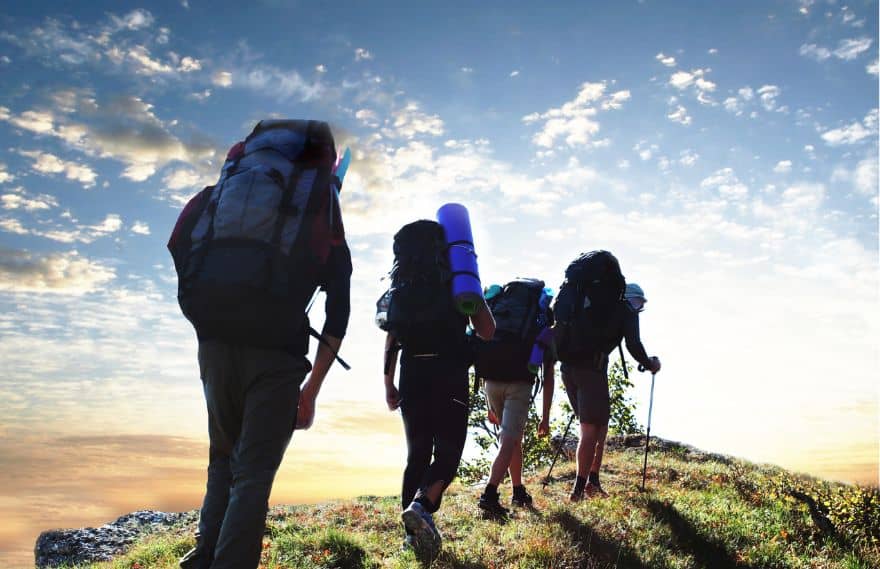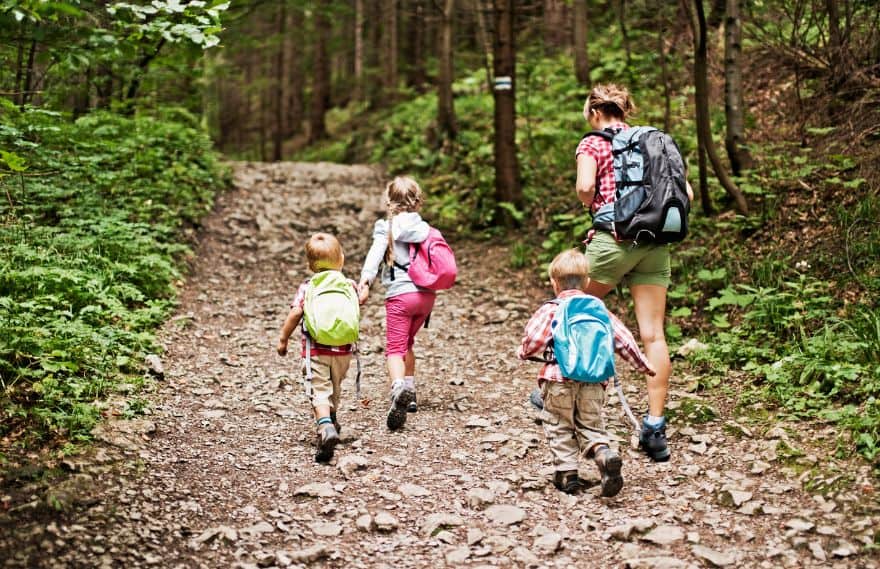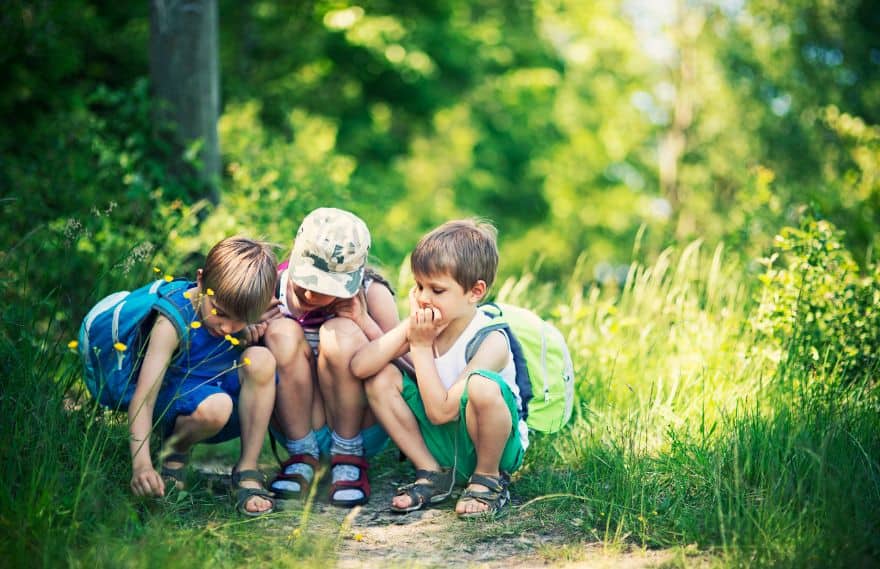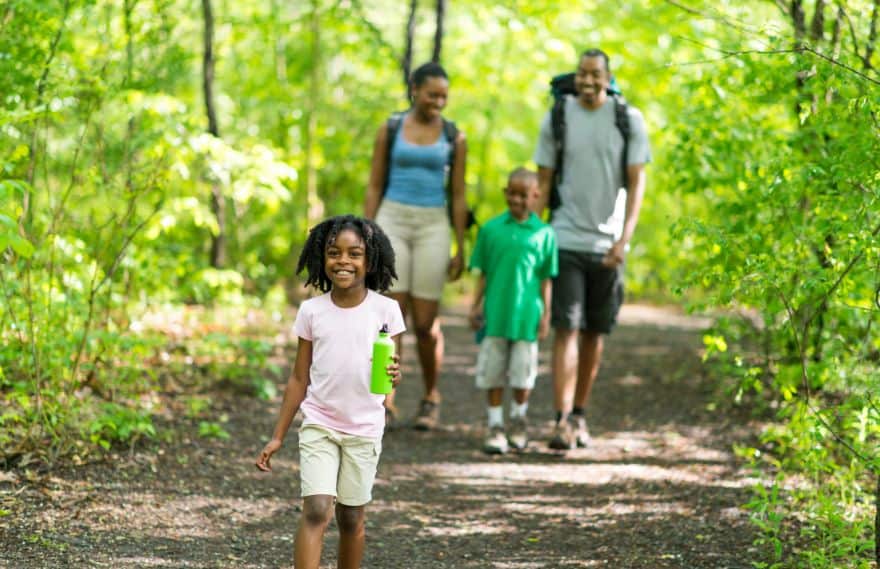Over the years, my daughters and I have created routines that allow us to explore various outdoor activities. So far, hiking is their favorite because we get to explore something new every time. It’s so exciting! However, before we became a “pro†hiking family, I had to understand the best types of hiking and how to hike with kids. With that said, I want to highlight various types of hiking and guide you in selecting the perfect one for your child.
The different types of hiking include backpacking, day, long-distance, and summit hiking. They’re all adventurous, but some, like the long-distance hikes, might not be conducive for kids due to the long trails.
But before we figure out how to pick the best type of hiking for kids, let me describe all the different types in-depth.
1. Day Hiking
Day hiking is the most common type and the easiest for beginners. As the name states, the hike only occurs during daylight hours and doesn’t involve camping. Usually, day hikes involve simple 30-minute walks along a trail or three-hour walks across a mountain trail. For example, you will take the kids to a nearby forest or mountain trail and be home before sundown.
2. Backpacking
Unlike day hiking, backpacking definitely involves camping. In fact, it is also referred to as an overnight hike because you will spend at least one night away from home. Typically, hikers follow general or stage trails and set up camp at the end of that trail.
Backpacking is good for beginners and experts because you decide where your adventure ends. Hikers also carry heavier bags, tents, and hiking essentials when backpacking. Generally, backpacking could be part of a long-distance hike or a day hike that doesn’t involve going back home.

3. Long Distance Hiking
Long-distance hiking offers the best experience, but it’s not for the fainthearted. You will spend weeks or months traversing through long technical trails. In fact, there are designated trails worldwide for long-distance hikers, including the Pacific Coast Trail and Appalachian Trail.
Long-distance hikes are more physically and mentally demanding, which requires resilience. Most hikers complete these hikes as a group and rarely turn back once the hike commences. Normally, the hikers complete the journey in two unique ways;
- Section hiking
The hikers will complete the long-distance hike in sections. For example, if you’re hiking through the Via Alpina Red Trail, you’ll traverse Slovenia, Austria, Italy, Germany, Switzerland, France, Liechtenstein, and Monaco. The hike is over 1000 miles long, so hikers divide it into sections based on the miles, completion timeframe, or country.
- Thru-hiking
Thru-hiking requires more commitment than section hiking. You’ll spend an extended time on the trail as a backpacker. The long-distance hikers will commit to one trail and pursue it to completion. For example, the Red Trail features five trails across eight countries. Therefore, the hikers will complete the Red Trail hike in five stages. Unlike section hikers who can create flexible sections, thru-hikers are fully committed to one trail at a time.
I haven’t done a long-distance hike yet, but I’d love to someday. Hopefully, with my entire family when the girls are physically and mentally ready. But until then, we’ll enjoy out-and-back hiking and backpacking to our favorite spots.
Furthermore, long-distance hiking isn’t the best for kids, especially if they’re beginners. So let’s explore how to identify the best hiking experience for your child.
How to Choose the Best Type of Hiking for Kids
1. Consider the Age
Hikes require commitment and tolerance, so you should definitely consider your child’s age. Generally, you don’t expect a 7-year-old to have the same tolerance as a 16-year-old. 16 years old teens can traverse a long-distance hike, but younger kids will only thrive during shorter hikes.
Don’t forget that the younger they are, the more their demands and tantrums. So, if you have younger children, day hikes are better. If they’re around 5 years, you can introduce backpacking with one-day trips to see how they react. Of course, if you have teenagers, you will follow their lead and introduce longer trails to prepare for long-distance hiking.

2. Talk to Your Kids
My girls are older and have no problem selecting trails for themselves. But that wasn’t always the case. I would always pick out our trails when they were younger, around 5 and 7 years.
They enjoyed some and would throw full-on tantrums on other trails, wanting to turn back. As they grew, I began to seek their participation, and it paid off because nowadays, we pick a trail together, and rarely does anyone complain.
I’m mentioning this to let you know it’s okay to involve your children in hiking decisions. After all, they will also benefit greatly from hiking activities. Start by showing them different trails on maps or videos and ask them to choose one.
Then, please find out how they feel about hiking and let them help you create the itinerary. When the kids feel involved, they’ll enjoy day hikes, backpacking, and, eventually, long-distance hikes.
3. Do Your Research
I spend hours researching whenever we have a hiking trip lined up in my household. Usually, we’ll do it over the weekend, but we also throw in backpacking activities when schools close. So I research a lot to understand the trail distance and obstacles to determine if it’s manageable for the girls.
Of course, they’re older and more resilient than when we first started, but I never want to pick hikes that will discourage them. Now and then, I’ll also ask for their opinion and include them in research to find suitable trails.
The research will help you find kid-friendly terrains if you’re bringing kids along. Study potential trails using maps, park websites, hiking apps, online reviews, or friend referrals. Thanks to modern technology, satellite photos will give a detailed overview of existing trails.
4. What’s Your Time Allocation?
The different types of hiking take varying amounts of time. For example, day hikes are one-day activities that will take as little as 30 minutes, whereas backpacking takes at least one night from home. In this case, both activities are conducive for kids, but you have to estimate the amount of time you’ll need to complete a trail.
In the beginning, you will have to choose shorter and simple trails. Afterward, you can increase the time gradually as you monitor how the kids ease into these activities. In fact, day hikes are always a good option for kids. Complete 30-minute out-and-back hiking on the first few hikes before you introduce hour-long hikes or backpacking.
5. Select Familiar Trails
I began hiking long before my daughters were born, so I had the advantage of identifying kid-friendly and less challenging trails. If you’re an experienced hiker, you can use that to your advantage, but if you’re a beginner, a little research goes a long way.
Find the most popular trails in your area and start there, avoiding technical trails and areas that will pose a danger for the kids. Furthermore, if you traverse a familiar trail and get lost, it’s easier to find help because these routes are often busy.

6. Select Trails with Kid-Friendly Features
Apart from familiar trails, kids also enjoy activity-filled hikes. That way, the hike does feel like a never-ending and tiresome walk. Generally, long-distance hikes are more scenic and fun, but they’re not accommodating for beginners (especially beginner kids).
Therefore, pick out scenic and simple trails to keep your kids engaged throughout the hike. Of course, the activities should be safe and age-appropriate. For example, if you’re hiking with toddlers, go for mellow terrains that feature benches or logs every few kilometers. You know the kids will want to rest and play in between. In addition, look for shorter trails and lots of scenic features.
For elementary kids, I recommend trails that include climbing and options for imaginative play, such as rocks, water, insects, and flowers. At this age, you can go for summit hikes so the kids can overcome challenges and feel accomplished once they make it to the top. Remember, you should always start with short or lower summits and work your way to more challenging terrains.
Teenagers are pretty much independent, so if they’re motivated, they can adapt quickly to any hike, including long-distance hiking. For teens and elementary kids, include dog-friendly trails, longer terrains, wildlife, unique vegetation, and other educational features. In fact, you should pack a pair of binoculars, so they view the scenic features and engage in activities like scavenger hunts.
7. Involve a Professional
If you’re not familiar with trails or how to navigate the different types of hikes, you should involve a professional. Park rangers and hiking instructors are the best point people for all your hiking needs. Most hiking trails are registered within parks or forests, making it simple. Visit the offices and learn all you need about their trails.
Once you know the best routes for kids, camping spots, and movement logistics, you’ll be comfortable selecting a trail for your babies. Even better, you can use a paid guide to traverse these trails because they know where all the fun activities for kids are situated. Alternatively, you can take a solo hike with the guide to master the path, then tag your kids on the next one.
Important Tips to Note When Hiking With Kids
Hiking with kids is fun, educational, and good for their physical wellness. However, if you’re not prepared, even the short day trips will feel like long-distance hikes. Trust me; I have a lot of interesting hiking stories to share. Therefore, from my experiences, I’ll highlight important tips to help you navigate all types of hiking with kids.
1. Be Patient
I can’t stress this enough, but be patient with your babies, especially if they’re still not used to outdoor activities. Nowadays, kids would rather stay indoors 24/7, so if you want to develop a love for outdoor activities, you must start slow and avoid forcing them to do anything.
For example, if they can only manage one hour for out-and-back hiking, take a 30-minute trail, and go to and fro within an hour. Also, include frequent stops so they can re-energize and take in the views. Gradually, they’ll start to initiate these outdoor activities themselves. After all, you know what they say, “nature nurtures the soul.â€

2. Bring Snacks and Lots of Water
If you want to keep your kids outdoors for a long time, you better ensure they’re well-fed and hydrated. Moreover, hiking takes a toll on the body, and dehydration is inevitable. Therefore, as you prepare for the hike, include your kids’ favorite snacks, fruits, drinks, and enough drinks.
Usually, I’ll carry a blanket so we can set up a picnic spot and enjoy the views as we eat. What’s more, when your kids are full, the tantrums are less, and you can hike for longer.
3. Follow Your Kid’s Lead
As much as you want to take charge and guide the hike, it is crucial that you follow your baby’s lead. Ask them to set goals for the hike, maintain their pace instead of rushing, and allow them to explore everything (as long as they’re safe).
If your child says she’s tired, take a minute and let them rest. That way, they won’t hate the hike. In fact, the stops are an excellent time to explore nature, wildlife, and the views.
In general, day hikes are the best for introducing kids to hiking. You can choose simpler trails with child-friendly activities and set reasonable hiking time frames. However, as they adapt, please don’t shy away from introducing other types of hiking and challenging obstacles that build their physical and mental endurance.
I will let you in on a little secret. Keeping kids motivated on a hike is not always easy. It’s best to prepare for it, so they don’t get bored or too tired to move. Luckily, I got you covered with a few tips on how to keep them motivated and moving, plus games you play while hiking.




